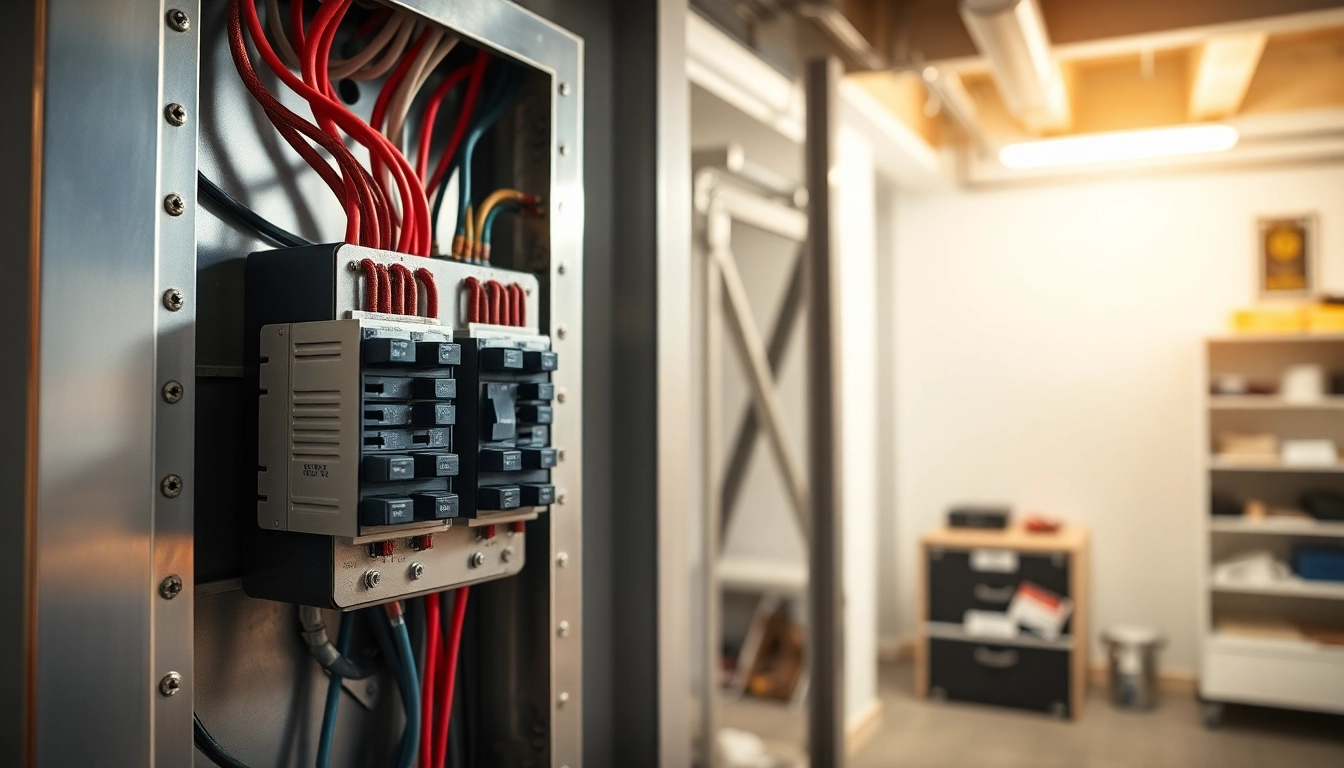Evaluating the Need for an Electrical Panel Upgrade
In the modern home, an efficient and safe electrical system is essential. As appliances become more power-hungry and our reliance on electricity increases, homeowners often find themselves asking if it’s time for an Electrical Panel Upgrade. Recognizing the need for an upgrade can save homeowners from potential hazards and enhance the overall performance of their electrical systems.
Signs Your Electrical System Requires an Upgrade
The first step in assessing whether an electrical panel upgrade is necessary is to look for specific indicators. These signs not only highlight potential deficiencies but also underline the importance of a functional electrical system:
- Inconsistent Power Supply: Flickering lights or appliances cutting in and out can indicate that your current panel cannot handle the load.
- Frequent Circuit Breaker Trips: If breakers frequently trip or fuses blow, this signals the panel is overloaded, unable to handle the electrical demands of your home.
- Age of the Panel: Electrical panels over 20 years old may not comply with modern safety standards and can pose serious risks.
- The Need for More Circuits: If you’re adding more appliances or renovations, an older panel may not support additional circuits.
- Rust or Damage: Visibly damaged or rusty panels can be a sign of serious issues. Moisture and corrosion can affect the electrical integrity.
Common Reasons for Electrical Panel Upgrades
Upgrading your electrical panel can stem from several common reasons:
- Increased Home Demand: With the proliferation of electronics (smart devices, home offices, EV chargers), homes often find their original electrical capacity inadequate.
- Safety Compliance: Older panels may not meet current National Electrical Code (NEC) standards, making upgrades essential for safety.
- Enhanced Ability to Support New Appliances: Modern homes commonly utilize high-powered appliances such as HVAC systems, energy-efficient washers, and dryers that require additional amperage.
- Home Renovations: If you’re expanding your home or adding more rooms, you may need a panel upgrade to accommodate new wiring and outlets.
Understanding Your Home’s Electrical Capacity
Every electrical panel has a specific capacity, measured in amps, which indicates the maximum amount of current it can handle. Most older homes have 100-amp service, whereas newer constructions or significant upgrades typically require 200 amps or more. Understanding your home’s demand versus capacity is vital. Here’s how to assess:
- Calculate Appliance Load: List all significant electrical appliances and their amperage needs to understand if your current panel suffices.
- Consult an Electrician: Professional electricians can conduct load assessments and recommend appropriate upgrades to meet your home’s power needs.
Benefits of Upgrading Your Electrical Panel
Upgrading your electrical panel offers numerous benefits that enhance not only safety but also the functionality of your home’s electrical system.
Increased Safety and Compliance with Modern Standards
Electrical safety is paramount. Old panels can lead to dangerous situations like short circuits and fires. Upgrading ensures compliance with the latest safety standards, reducing the risk of electrical hazards:
- Better Circuit Protection: Newer panels often include features like dual-function breakers which provide ground fault and arc-fault protection.
- Increased Monitoring: Modern panels can accommodate smart technology, allowing for real-time monitoring of electrical usage and alerts for potential problems.
Enhanced Power Distribution for Modern Appliances
As our reliance on high-wattage appliances grows, upgrading your panel allows for more efficient use and distribution of electrical power:
- Support for EV Chargers: With electric vehicles becoming increasingly popular, an upgraded panel ensures your home can support Level 2 EV chargers with ease.
- Improved Functionality for Home Offices: As remote work continues, a robust electrical system supports the necessary technology without risking overload.
Potential for Higher Home Value
An upgraded electrical panel can enhance your home’s value, making it more attractive to potential buyers. Home buyers often look for updated electrical systems that promote safety and efficiency:
- Market Appeal: An updated panel makes a significant selling point that assures buyers of a safe and efficient home.
- Compliance with Building Codes: Having an electrical panel that meets or exceeds building codes can be a major selling advantage.
Cost Considerations for an Electrical Panel Upgrade
The costs associated with upgrading an electrical panel can vary significantly based on numerous factors. It’s important to be fully informed about what goes into the price of an upgrade:
Typical Costs and Factors Influencing Pricing
Costs for upgrading an electrical panel can range from $800 to $4,000, and understanding the implications behind these numbers is essential:
- Panel Amperage: Upgrading from 100-amps to 200-amps can cost around $1,300 to $3,000 on average, dependent on labor and location.
- Location: The geographic area plays a significant role in how much electrical work costs due to varying regulations and labor costs.
- Existing Wiring Issues: If your home has outdated wiring or other issues, the costs can increase significantly due to necessary repairs during the upgrade.
Comparing DIY vs Professional Installation Expenses
While some homeowners might consider a DIY approach to save money, many factors should be taken into account:
- Safety Risks: Working with electricity can be dangerous. Improper installation can lead to serious hazards that often outweigh the cost-saving.
- Permits and Codes: Electricians are well-versed in local codes, ensuring that the work passes inspection and reduces the risk of penalties or paperwork nightmares for homeowners.
Exploring Financial Incentives and Rebates
When planning for an electrical panel upgrade, it’s worth investigating any available financial incentives:
- Utility Rebates: Programs in many regions offer financial rebates for energy-efficient upgrades, including electrical panels.
- Tax Credits: Certain upgrades may qualify for tax credits, which can significantly offset costs. For example, some homeowners may qualify for credits related to energy-efficient electrical systems.
The Upgrade Process: What to Expect
The process of upgrading your electrical panel involves several key steps that can help you understand what to expect during installation:
Initial Assessment: What Electricians Will Check
Before any work begins, an electrician will conduct a comprehensive inspection of your electrical system:
- Evaluating Current Panel Condition: They will assess the existing panel for any wear, damage, or code violations.
- Load Requirement Assessment: An electrician will determine your home’s total electrical load needs.
- Identifying Necessary Upgrades: This includes checking for outdated wiring or any other issues that need to be resolved before the panel upgrade.
Steps Involved in the Electrical Panel Upgrade
After the assessment, the upgrade process generally follows these steps:
- Disconnection: The electrician will turn off the main power supply to your home.
- Removal of Old Panel: The old electrical panel will be carefully removed and disposed of.
- Installation of New Panel: The new panel is installed, wiring is connected, and circuits are added as needed.
- Inspection: After installation, an inspection by local electrical authorities may be required to ensure compliance with codes.
- Power On: Once approved, your new panel will be powered on, ensuring everything runs smoothly.
Timeline: How Long Does it Take?
Generally, an electrical panel upgrade can take anywhere from a few hours to a full day, depending on:
- Extent of the Upgrade: More complex upgrades will naturally take longer.
- Preparation Work: If additional wiring or repairs are needed, the time required can increase significantly.
Post-Upgrade: Maintenance and Safety Checks
After the upgrade, maintaining your electrical system becomes paramount to ensure continued safety and efficiency:
Routine Maintenance Tips for Your Electrical Panel
To promote longevity and safety, regular maintenance of your electrical panel is important:
- Visual Inspections: Regularly check for rust, dirt, or moisture in the panel area.
- Observe Elevated Temperatures: If the panel feels warm, it may indicate an issue that requires immediate attention.
- Schedule Annual Professional Inspections: A yearly electrical inspection can identify potential problems before they worsen.
Recognizing Warning Signs After an Upgrade
Even after an upgrade, it’s crucial to watch for warning signs that may indicate issues:
- Persistent Flickering Lights: Indicates possible wiring issues or that the panel is still under strain.
- Unusual Noises: Buzzing or popping sounds can suggest problems with the panel or circuitry.
Resources for Understanding Electrical Safety Standards
Staying informed is key to electrical safety. Resources like the National Fire Protection Association (NFPA) and the National Electrical Safety Code (NESC) can provide valuable guidance on maintaining electrical systems:
- Webinars and Workshops: Many local electric companies offer community education sessions on electrical safety standards.
- Local Building Codes: Consult with local authorities about any regulations that pertain to home electrical systems for compliance and safety.


